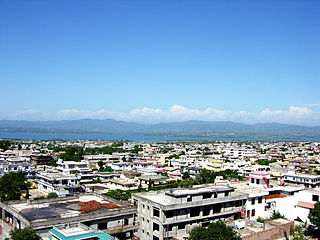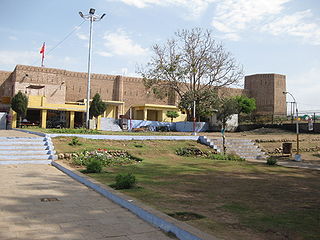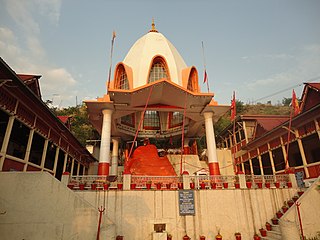
The Kashmiri Pandits are a group of Kashmiri Hindus and a part of the larger Saraswat Brahmin community of India. They belong to the Pancha Gauda Brahmin group from the Kashmir Valley, a mountainous region located within the Indian union territory of Jammu and Kashmir. Kashmiri Pandits are Hindu Kashmiris native to the Kashmir Valley, and the only remaining Hindu Kashmiris after the large-scale of conversion of the Valley's population to Islam during the medieval times. Prompted by the growth of Islamic militancy in the valley, large numbers left in the exodus of the 1990s. Even so, small numbers remain.

Mirpur, officially known as New Mirpur City, is the capital of Mirpur district located in Azad Kashmir, Pakistan. It is the second largest city of Azad Kashmir and 74th largest city in Pakistan.

Doda district is an administrative district of the Jammu division of Indian-administered Jammu and Kashmir in the disputed Kashmir region.

Mohyal Brahmins are an Indian sub-caste of Saraswat Brahmins from the Punjab region.

Reasi district is an administrative district in the Jammu division of Indian-administered Jammu and Kashmir in the disputed Kashmir region. The Reasi district is bordered by Udhampur district and Ramban district in the east, Jammu district in the south, Rajouri district in the west and by Kulgam district on the north. The Reasi and Rajouri tehsils formed a joint district called the "Reasi district" at the time of princely state's accession to India in 1947. As part of the reorganisation, the two tehsils were separated and Reasi was merged with the Udhampur district. It again became a separate district in 2006.
Gurjar is an Indo-Aryan agricultural ethnic community, residing mainly in India, Pakistan and Afghanistan, divided internally into various clan groups. They were traditionally involved in agriculture, pastoral and nomadic activities and formed a large heterogeneous group. The historical role of Gurjars has been quite diverse in society: at one end they have been founders of several kingdoms and dynasties and, at the other end, some are still nomads with no land of their own.

Kashmiri Muslims are ethnic Kashmiris who practice Islam and are native to the Kashmir Valley in Indian-administered Kashmir. The majority of Kashmiri Muslims are Sunni. They refer to themselves as "Koshur" in their mother language.

The Bahu Fort is a historic fort in the city of Jammu, the winter capital of the Indian union territory of Jammu and Kashmir. Constructed on the banks on Tawi River, the ancient fort is believed to have been constructed by Bahu Lochan - brother of the traditional founder of Jammu, Jambu Lochan. It is believed that the first renovation of this fort was undertaken during Dogra Rule in 18th century. The fort is a religious place, and within its precincts has a temple dedicated to the Hindu goddess Kali. The temple is known locally as the "Bawe Wali Mata temple".
The Dogra Muslim are a Muslim community found in the Indian state of Jammu and Kashmir. They are Muslim converts from the larger Hindu Dogra community. Many Dogra Muslim are also now found in the province of Punjab in Pakistan. They are also known as Rajahs, especially in Pakistan.
The Batwal are a suryavanshi rajput clan found in the Indian states of Rajasthan, Madhya Pradesh, Maharashtra, Jammu and Kashmir, Punjab and Himachal Pradesh.
The Dogra Jheevar are a Hindu caste found in the Jammu region of Jammu and Kashmir, India.
The Lalotra is a Hindu Rajput clan found mainly in the Indian states of Punjab, Himachal Pradesh and Jammu and Kashmir. The Lalotra's were also found in Sialkot District, and these Lalotra's immigrated to India at the time of the Partition of India. They are a Dogra sub-group, and their customs are similar to other Dogras.
The Rattal are a Hindu Rajput caste found in Jammu and Kashmir, India, who are of Suryavanshi clan. According to the 2001 Census of India, their population was 1,913.
The Basith are a Hindu caste found in Jammu and Kashmir. According to the 2001 Census of India, the caste had 18,866 members.

Kashmiri Hindus are ethnic Kashmiris who practice Hinduism and are native to the Kashmir Valley of India. With respect to their contributions to Indian philosophy, Kashmiri Hindus developed the tradition of Kashmiri Shaivism. After their exodus from the Kashmir Valley in the wake of the Kashmir insurgency in the 1990s, most Kashmiri Hindus are now settled in the Jammu division of Jammu and Kashmir and other parts of the country. The largest group of Kashmiri Hindus are the Kashmiri Pandits.

The Jammu division is a revenue and administrative division of the Indian-administered Jammu and Kashmir in the disputed Kashmir region. It is bordered by the Kashmir division to the north. It consists of the districts of Jammu, Doda, Kathua, Ramban, Reasi, Kishtwar, Poonch, Rajouri, Udhampur and Samba. Most of the land is hilly or mountainous, including the Pir Panjal Range which separates it from the Kashmir Valley and part of the Great Himalayas in the eastern districts of Doda and Kishtwar. Its principal river is the Chenab.

Jammu is a city in Indian-administered Jammu and Kashmir in the disputed Kashmir region. It is the winter capital of Jammu and Kashmir, which is an Indian-administered union territory. It is the headquarters and the largest city in Jammu district. Lying on the banks of the river Tawi, the city of Jammu, with an area of 240 km2 (93 sq mi), is surrounded by the Himalayas in the north and the northern plains in the south. Jammu is the second-most populous city of the union territory. Jammu is known as "City of Temples" for its ancient temples and Hindu shrines.
Chapa or Chap is a clan of the Gurjar ethnic community of northern India.

Jammu and Kashmir is a region administered by India as a union territory and consists of the southern portion of the larger Kashmir region, which has been the subject of a dispute between India and Pakistan since 1947 and between India and China since 1959. The Line of Control separates Jammu and Kashmir from the Pakistani-administered territories of Azad Kashmir and Gilgit-Baltistan in the west and north. It lies to the north of the Indian states of Himachal Pradesh and Punjab and to the west of Ladakh which is administered by India as a union territory.
The Pahari people or Pahari-speaking people is a cover term for a number of heterogeneous communities inhabiting in Jammu and Kashmir and also some parts of Pakistan administered Azad Kashmir who speak Pahari languages/dialects.










